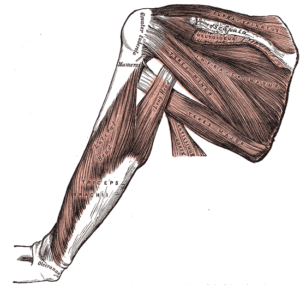The rotator cuff is four muscles that work together to stabilize the shoulder joint. All four of these muscles connect the shoulder blade to the humerus or arm bone.
- Infraspinatus externally rotates and extends the arm.
- Teres minor externally rotates and extends the arm.
- Subscapularis internally rotates the arm.
- Supraspinatus moves the arm away from the body and stabilizes the head of the arm in the shoulder socket.
But what makes these muscles different from all other muscles? Major shifts occurred when human beings came to stand.
One radical change was the new found freedom of the arm to move in pretty much any way it desired.
This was a major leap from either the compressive shoulder of the quadruped or the suspended shoulder of the ape that swings from the trees.
The hip joint and the shoulder joint are both ball and socket joints which allow for a great deal of motion. But the excessive movement of the hip joint is limited by the ligament that holds the ball into the socket.
The iliofemoral ligament might be the strongest ligament in the entire body as the hip joint is one of our main weight-bearing joints.
The shoulder joint is the opposite of the hip joint. There is a ball at the end of both the arm and the leg bones but while the hip socket is actually a socket, the spare shoulder socket is made up of three bony parts of the shoulder blade—the acromion process, the coracoid process, and the glenoid fossa.
There is a cup of cartilage called the labrum that connects the humerus to the shoulder blade along with ligaments that should, according to their function in the rest of the body, provide the stability to keep the arm bone in the shoulder socket.
But there are strange forces at play that makes the rotator cuff muscles susceptible to dysfunction and injury.
The job of ligaments is to hold the bones together and they are meant to be very strong with very little give.
Loose ligaments, as anyone who has them will attest, can be hell on existence. But if the ligaments of the shoulder joints had the same tensile strength as ligaments in the rest of the body we would have much more limited arm movement.
How did the body provide for this newfound freedom of the arm?
It made the ligaments of the shoulder joint loose enough to allow for an incredible range of motion in all planes, and made the tendons of the rotator cuff muscle act like ligaments to stabilize the joint.
That’s just crazy! This is one of the more interesting anomalies in the body and I believe our shoulders have suffered for it as we try to learn and work with our relatively new evolutionary traits.
Soon we will look at classic rotator cuff injuries as well as exercises for strength and support of the rotator cuff.
***

